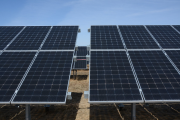At 10:57 p.m. on Sunday, June 16, Alberta’s last coal plant went offline. An official announcement shortly followed, quietly signalling the end of coal-fired electricity in Alberta.
Many organizations contributed to this successful campaign through advocacy and research. The Canadian Association of Physicians for the Environment, the Lung Association, and the Asthma Society of Canada were instrumental in highlighting the health impacts associated with air pollution from coal-fired electricity. The Pembina Institute, an Alberta-based clean energy think tank, first intervened in a coal plant regulatory process in the late 90s, and in 2009, published the first major proposal that showed Alberta could move to an unabated coal-free grid by 2030. Our research was ahead of its time and criticized as idealistic.
Coal accounted for 80 per cent of Alberta’s electricity grid in the early 2000s and it still amounted to 60 per cent of Alberta’s electricity generation only 10 years ago. When phasing out coal was just an idea being batted around, many said it couldn’t be done and it was unrealistic. This is not dissimilar to the rhetoric being batted around today around decarbonizing the grid. But Alberta’s experience phasing out coal shows environmental progress of this magnitude is possible.
In 2012, Prime Minister Stephen Harper mandated a nationwide phase-out of coal by 2061. A far-off target date that, nonetheless, provided certainty to the provinces and got the ball rolling for phasing out coal in Alberta. The Wildrose Party, then led by Danielle Smith, included a coal phase-out commitment in its 2012 election platform.
When the NDP came to power after the 2015 election, they got to work delivering on a plan to accelerate the phase-out of coal. This included strengthening Alberta’s industrial carbon pricing system, a commitment to 30 per cent renewables by 2030 and a target date for phasing out coal by 2030 – a target built through consultation with experts and industry. The current federal government made a similar national commitment in 2016.
At the time, there were concerns about the impact this would have on jobs. We learned that workers benefit from new investments in cleaner electricity – if included in strategic planning from the start. Federal and provincial programs to support workers during this transition were made available, while community economic diversification and growth in jobs in other sectors has helped to offset some of this change. Research also shows there are opportunities in clean energy, such as from increased land revenues and municipal taxes.
Phasing out coal in Alberta was supported by good policy design driven by carbon pricing and regulations with clear targets that offered necessary certainty to industry and stakeholders. Rapidly growing, low-cost renewable energy further supported the phase-out, along with companies investing in gas-fired electricity. All these actions accelerated the transition away from coal at a faster rate than anticipated.
So, for the first time in 150 years, coal is no longer part of Alberta’s electricity mix. It is important to celebrate and reflect on these milestones, while recognizing there is no time to rest before redoubling our efforts and looking to what’s next.
As the Pembina Institute’s latest research shows, many countries are striving to be the first to decarbonize their electricity system – and a decarbonized electricity system by 2035 is within reach in Canada. It would save households hundreds of dollars on their electricity bills, enhance the competitiveness of our industries, and attract more investments into Canada as industries all look to secure clean power. But, as with coal, powerful incumbents want to maintain the status quo. Neither Albertans nor our climate can afford to be locked in to burning greenhouse gas emitting natural gas when we have better, lower-cost alternatives.
Renewable energy is already the most cost-effective form of new electricity generation, and costs continue to drop. But we still need to bring online more wind and solar, along with storage. Historically a leader in renewable energy, Alberta’s seven-month renewables moratorium, new restrictions unique to renewables, and a market restructuring have chilled project development. Restoring certainty should be a priority for the government. Alberta also already has enough existing and planned gas on its grid to meet its electricity needs.
The future is abundant, affordable, zero-emissions electricity. But we also need to invest in updating our infrastructure to meet our modern-day needs. Alberta is behind on demand-side management measures – a tactic that has reduced energy demand by 15% and avoided building new infrastructure in Ontario. Canada is also behind on building interties between jurisdictions – an approach that supports resilient systems and allows us to benefit from our complementary strengths across the country in hydro and other renewables.
We urgently need to continue to reduce emissions and we have the tools to achieve this. As the coal example shows, success takes time – sometimes over the course of decades – and relentless fact-based advocacy.








